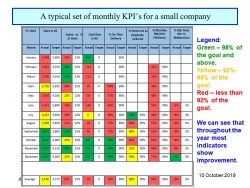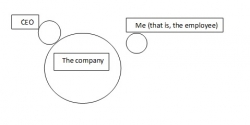I recently got a call from "Arnon", asking:
"Does improving the organizational culture and atmosphere in a company lead to savings, increased efficiency, and profits, and why isn’t it a social norm?"
Arnon and some of his friend read a presentation I gave six years ago as a guest lecturer in a course taught by Prof. Gil Loria at Haifa University, in which I also included comments from the students.
In this article I won't discuss the definition of organizational culture, and what can be called improving it, but rather focus on the impact a culture that promotes employee engagement can have on profits.
Who Creates the Comparative Advantage, the CEO or the Employees?
Let's assume Gad and Shim'on manage rival companies. Since they purchase supplies from the same manufacturers, costs are probably the same. Price of energy and capital are similar, and so are costs of labor.
So, which one will have more success? The comparative advantage?
In a conversation I had with Yeoshua during our morning bike-ride, he said a comparative advantage originates with the CEO. If the CEO is good, the company will prosper, and if the CEO is bad, the company will fail, and that's it.
I say that the CEO certainly has full responsibility for the company's performance. But a good CEO will achieve the comparative advantage through the company's employees.
For our example, we'll assume that Gad and Shim'on both have been in their position for over ten years, so if they were bad CEO their company would have closed or they would have been fired.
The local market is growing more competitive and diminishing, customs defenses are disappearing and imports make sales harder. Both Gad and Shim'on have turned to exports. They don't only compete with each other, but with the global market.
Will they be able to survive without getting their employees invested in the company's success? Will they be able to compete with the condition of quick employee-turnover (as is the norm in many industries), employees without motivation and with a smartphone in their hands?
Employee Engagement
Before I discuss my experience, I want to also rely on the vast academic body of research on the subject of employee engagement.
In the Employee Engagement article on Wikipedia you can find the following definition:
Employee engagement is a property of the relationship between an organization and its employees. An "engaged employee" is defined as one who is fully absorbed by and enthusiastic about their work and so takes positive action to further the organization's reputation and interests. An engaged employee has a positive attitude towards the organization and its values.
This entry also includes references to many academic papers comparing companies with engaged versus disengaged employees. They all show a clear advantage for the former.
Employee Stability, the Ultimate Indicator of Motivation and Employee Engagement. Incredible Data.
One of the definitive characteristics of a company where employees aren't engaged and motivated is employee instability. This can manifest as a difficulty to retain employees, especially new ones, and high absence rates among older employees who are afraid to leave and look for a new job.
Both of these trends are easy to measure, and I highly recommend you do so.
In my opinion and based on my extensive experience, these two indicators are the best in measuring employee motivation and engagement.
I previously published an article dealing with this issue, which had thousands of readers. I also included a poll about strategies of dealing with employee absenteeism. As of writing this article, 62% answered that their company has no strategy on addressing this. Incredible.
Not only is this incredible data, it also has expensive repercussions, because it means, in manufacturing, some machines are routinely not operated due to staff shortages, or that there is a habit of over-staffing to deal with possible absences. Both options have a high price tag.
In the broader context of this article, we can say that about two-thirds of companies or more don't at all work at creating employee engagement, or see its importance.
The Israeli industry has a systematic problem with employee retention and recruitment. We can shirk the responsibility and blame millennials or a lack of budgets from the government. But the fact is that in any given industry we can find companies with a high employee stability rate which have no problem recruiting new employees, as well as companies in the opposite condition.
How to Get Employees Motivated and Engaged? The Key is: "Every Employee is a Manager in Their House"
If we remember that every employee is a manger in their own house, dealing with income, expanses, and challenges, it will be easier for us to understand what their thinking is when they come to work and become a cog in a machine. A person whose opinion is discounted, never sought, and who isn't appreciated, and even, as the above discussed poll shows, whose very presence doesn't matter to the company.
Contrast that with an employee whose opinion is valued, who's listened to, who's involved in advancing the company, who receives constructive feedback, is valued and appreciated, and has open communication with management. Every employee comes to work from a home where they are the manager, with an open mind and initiative, and can continue to be that way at work. An employee whose opinions matter, and isn’t just a cog in a machine.
Isn't it clear which employee will contribute more to the company, and be its comparative advantage?
Management's POV
I used to work with a large company which had a maintenance manager who would say to employees he supervised, when they came to him with an idea: "you be quiet, I'm here to think, you're here to work" (I heard him say that with my own ears).
At another company, I worked with a manager who was very motivated and committed to the company, but used to call his employees "my shits". What commitment could he possibly expect from them? By the way, as part of a process of implementing lean-production in that company, he too changed his thinking and the way he spoke to and of his employees.
Tools for Getting Employees Motivated and Engaged
This issue has been extensively discussed in this blog. So I will only shortly list possible tools (it's important to note that I didn’t develop these tools. Most of them originated in Toyota many years ago, and are part of a method known as Lean-Production).
The tools:
- Improvement teams: building employee involvement in problem-solving and improvement processes. I've written extensively on the subject before, as you can see here.
- Transparency and sharing company stats with employees, as much as possible. See an article on the power of transparency.
- Managers who are also mentors. Managers on all levels who create a constructive and nurturing dialogue with their employees. Together with Anat Milner Cohen, I've built a training program to develop managers who are also leaders and mentors.
- Training for managers and employees.
- Sharing the organization's vision and values. Both through involving employees in their formulation, and training on their meaning, in order to implement them in the organizations daily operations.
- Especially for managers and executives: discussing expectations, defining roles and responsibilities, and goals and indicators.
In the above link to Wikipedia you can find a slightly different list of tools.
Summary and Recommendations
I began this article with the question – can an organization's culture affect its profits? From there I discussed how employees can be a company's comparative advantage.
Throughout the article I showed how promoting employee engagement and investment in the company's success can lead to decreased operation costs and increased profit. I think the key phrase at the base of this method is: "every employee is a manager in their own house, ensure that they have an open mind and initiative in the workplace as well."
The main tools used to achieve this are: improvement teams, transparency, managers who are mentors, training, sharing and implementing a vision and values, and clear role definitions.
If you are interested in my professional help, personally or for your company, the best way is to send a request through the Get in Touch form in my website (here).












 My First Book: Manage! Best Value Practices for Effective Management
My First Book: Manage! Best Value Practices for Effective Management